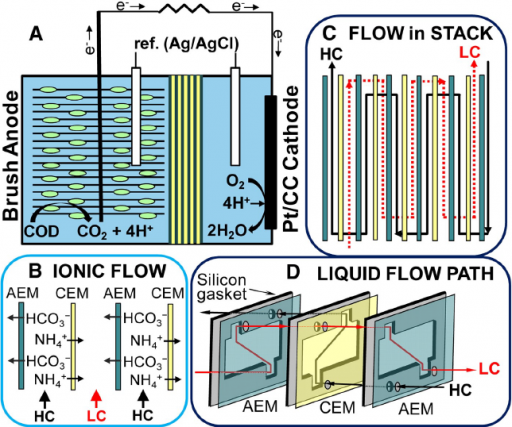Giving waste water the power to clean itself
March 2, 2012 | Source: Nature News

Microbial reverse-electrodialysis cell. (A) Main components of the microbial reverse electrodialysis cell (MRC), showing the membrane stack between the electrodes, the reference electrodes and the circuit containing a load (resistor). (C) Expanded view of the membrane stack showing flow path of the high (HC) and low (LC) concentrate solutions of ammonium bicarbonate. (Credit: Roland D. Cusick et al./Science)
A technique that combines two novel forms of renewable energy — one relying on bacteria and the other on salt water — generates more electricity than either one alone and cleans waste water at the same time.
The Pennsylvania State University researchers show that this configuration can achieve maximum power densities of 3 watts per meter squared, much higher than either technology can achieve on its own.
One method for converting this energy to a useable form is to use microbial fuel cells (MFC). These generate electricity by using cultures of microorganisms to break down and oxidize organic matter, a process that releases electrons that migrate towards a positive electrode.
To boost the power density of the MFC system, the researchers added a second process, called reverse electrodialysis (RED), in which the salinity gradient between fresh water and sea water is harnessed to generate electricity.
The researchers’ system, called a microbial reverse-electrodialysis cell (MRC), sandwiches a reverse electrodialysis (RED) stack made up of only a few pairs of membranes between the two chambers of an MFC, where the proton-exchange membrane would normally be.
Ref.: Cusick, R. D., Kim, Y., Logan, B. E., Energy Capture from Thermolytic Solutions in Microbial Reverse-Electrodialysis Cells, Science, 2012 [DOI: 10.1126/science.1219330]